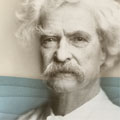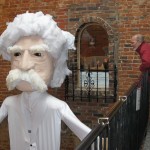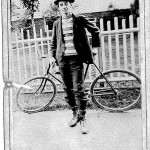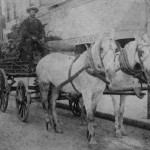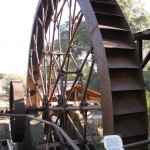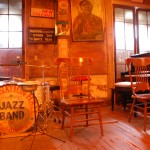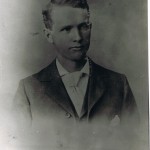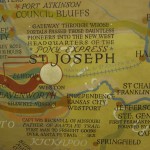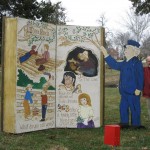
The site of the future John W. Jones Museum, dedicated to a former slave who respectfully buried Confederate soldiers
Elmira, Ny.—a rust-belt railroad and manufacturing town of 29,200 that has lost 40 percent of its population since 1950—promotes itself as Mark Twain Country.
Home to Twain’s burial site and the Quarry Farm study where he wrote some of his most important works during 20 summers, Elmira revels in Mark Twains—from the Mark Twain Golf Course to the Mark Twain Travel Agency to Elmira College’s Center for the Study of Mark Twain.
But Elmira also recognizes two other residents, Frank Romeo and John W. Jones, with museums—well, almost museums.
Romeo came to Elmira from the southern Italian village of Molochio in 1912 at age 17. After U.S. military service during World War I that left him disabled, the entrepreneurial immigrant started selling popcorn from a pushcart in 1922. His New York State license from 1928 that permitted him “to hawk, peddle and vend.”
In 1928 a Chevrolet dealer provided a truck chassis that Romeo had made into the “Red Wagon.” From 1930 to his retirement in 1971, Romeo operated the popcorn truck at an intersection near Elmira’s Wisner Park. He sold the truck to a Bearsville, Ny., man who, after 15 years, offered to donate the popular truck to Elmira. The city did nothing.
But a group of antique-car enthusiasts started a restore-the-truck drive in 1988 with a fundraiser at which Romeo’s wife signed popcorn boxes that were then auctioned.
Organized as the Popcorn Truck Preservation Society, the enthusiasts built a glass-walled garage on the east end of Wisner Park, near where Romeo had sold popcorn for 41 years. The red-brick-and-green-trim building blends perfectly with the First Baptist Church building, now unoccupied, behind it.
If lucky you’ll visit Elmira on a day when the garage-museum is empty because the Preservation Society has put the Red Wagon to its intended use, the sale of what residents call the best popcorn in town.
John W. Jones, a runaway slave who escaped to Elmira by Underground Railroad in 1844, became an Underground agent in 1851. He arranged with Northern Central railroad workers to hide fugitive slaves in a baggage car that took them eventually across the Canadian border to St. Catherine, Ontario.
Jones reportedly sheltered many in his own home behind First Baptist Church. Of the 800 slaves he helped, none was captured and returned to the South.
As sexton for First Baptist Church, Jones took charge of all city burials. He felt responsible for the 12,123 Confederate soldiers locked behind the 12-foot-high stockade fence of Elmira Prison. In the year of the prison’s operation, 1864-65, about a quarter of the prison’s inmates died.
Poor health, a severe winter, overcrowding, scurvy and terrible sanitary conditions included contaminated drinking water caused the death of 2,963 inmates. A compassionate Jones buried every one and kept careful records (only seven are listed as unknown).
A memorial erected by Elmira High School students at Woodlawn National Cemetery remembers the Confederate soldiers buried “with kindness and respect” by Jones: “They have remained in these hallowed grounds…by family choice because of the honorable way in which they were laid to rest by a caring man.”
In 1998 Jones’ farm house at 1259 College Ave. was threatened with demolition. A local group decided to restore the house as the John W. Jones Museum, using recycled lumber, some possibly from Elmira Prison buildings. The group moved the house to 1250 Davis St., still on the Jones farm and across the street from Woodlawn Cemetery.
Restoration of the house has stalled (the building permit in the front window is dated Nov. 18, 2008). But Lucy Brown, president of the museum’s board, hopes the museum’s completion will honor the legacy of John W. Jones and “respect the dignity of every human being.”
Loren Ghiglione
